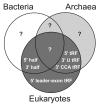Slicing tRNAs to boost functional ncRNA diversity
- PMID: 24351723
- PMCID: PMC3917982
- DOI: 10.4161/rna.27177
Slicing tRNAs to boost functional ncRNA diversity
Abstract
Post-transcriptional cleavage of RNA molecules to generate smaller fragments is a widespread mechanism that enlarges the structural and functional complexity of cellular RNomes. Substrates for such RNA fragmentations are coding as well as non-protein-coding RNAs. In particular, fragments derived from both precursor and mature tRNAs represent one of the rapidly growing classes of post-transcriptional RNA pieces. Importantly, these tRNA fragments possess distinct expression patterns, abundance, cellular localizations, or biological roles compared with their parental tRNA molecules. Here we review recent reports on tRNA cleavage and attempt to categorize tRNA pieces according to their origin and cellular function. The biological scope of tRNA-derived fragments ranges from translation control, over RNA silencing, to regulating apoptosis, and thus clearly enlarges the functional repertoire of ncRNA biology.
Keywords: RNA fragmentation; RNA processing; RNA silencing; non-coding RNA; tRNA halves; tRNA-derived fragments; translation regulation.
Figures


References
Publication types
MeSH terms
Substances
LinkOut - more resources
Full Text Sources
Other Literature Sources
